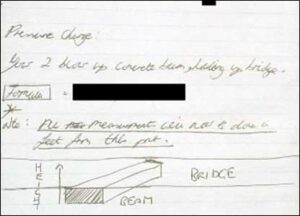March 10, 2017
This is the second article in our series discussing real-world terrorist operational planning written by TRAPWIRE Director Michael Maness. (The first article, on an operation conducted by the Red Army Faction in Germany, can be found here.) Mike spent two decades as a senior operations officer and field manager with the Central Intelligence Agency and was involved in counterterror investigations ranging from Pan Am 103 through 9/11. Mike’s real-world experience, like others working at TrapWire, brings a unique perspective to our counterterror services.
In 2004, acting on a tip from a recently arrested terrorism suspect, Pakistani police raided an Al-Qa’ida safehouse in Gujarat, Pakistan. Among the large amount of evidence collected at the scene were several laptops and 51 compact discs containing details on numerous Al-Qa’ida operations in the US and UK. The discovery of this treasure trove of surveillance and operational plans was a shock to the intelligence and law enforcement communities. The target list was extensive and included the Prudential Plaza in Newark, New Jersey, the World Bank and IMF headquarters buildings in Washington D.C., and the New York Stock Exchange, Citicorp Center and several Jewish targets in New York City. Even more surprising was the fact that much of this surveillance and pre-attack intelligence collection had been conducted by a single individual, and had taken place in New York before AND after the attacks on September 11th.
This begs the obvious question: How did a lone Al Qa’ida operative manage to conduct surveillance and pre-attack operations in a city that had just undergone the single greatest terror attack in US history? A city that many assumed was “buttoned up tight” in the aftermath of the attacks?
The answer is simple — he took advantage of the “Gates, Guns and Guards” mindset that existed at the time, which was completely focused on reacting to and repelling attacks, rather than trying to detect and stop them in the preparatory stages.
 Dhiren Barot was born in 1971 in India. His parents moved to the UK in 1973 where he attended school and eventually gained employment with Air Malta as a ticket agent in central London. After converting to Islam at the age of 20, he travelled to Pakistan in 1995 and took part in military operations against Indian forces in the Kashmir region. His early experiences prompted him to write a book, “The Army of Madinah in Kashmir,” in which he described various techniques to inflict harm on enemy soldiers. A bookstore owner named Moazzam Begg helped publish the book. It was through Begg that Barot probably made his first contact with Al-Qa’ida, where he eventually came to the attention of Khalid Sheikh Mohammed (KSM), Al-Qa’ida’s Director of Operations. KSM provided additional training in surveillance, pre-attack intelligence collection operations, and procurement of weapons and explosives. Barot quickly distinguished himself as an excellent surveillant and attack planner, and produced a 39-page memo on surveillance techniques and the use of everyday items in the construction of improvised explosive devices that was shared throughout Al-Qa’ida.
Dhiren Barot was born in 1971 in India. His parents moved to the UK in 1973 where he attended school and eventually gained employment with Air Malta as a ticket agent in central London. After converting to Islam at the age of 20, he travelled to Pakistan in 1995 and took part in military operations against Indian forces in the Kashmir region. His early experiences prompted him to write a book, “The Army of Madinah in Kashmir,” in which he described various techniques to inflict harm on enemy soldiers. A bookstore owner named Moazzam Begg helped publish the book. It was through Begg that Barot probably made his first contact with Al-Qa’ida, where he eventually came to the attention of Khalid Sheikh Mohammed (KSM), Al-Qa’ida’s Director of Operations. KSM provided additional training in surveillance, pre-attack intelligence collection operations, and procurement of weapons and explosives. Barot quickly distinguished himself as an excellent surveillant and attack planner, and produced a 39-page memo on surveillance techniques and the use of everyday items in the construction of improvised explosive devices that was shared throughout Al-Qa’ida.
 In 2000, Barot traveled to the US on a student visa, though there is no record of him every applying at any US university. Over the next three to four years Barot would travel back and forth
In 2000, Barot traveled to the US on a student visa, though there is no record of him every applying at any US university. Over the next three to four years Barot would travel back and forth
between the UK and the US conducting extensive surveillance operations against a wide variety of targets in both countries. It was his work against the Prudential building in New Jersey that showed exactly how meticulous and detail-oriented his operational planning had become. A good portion of Barot’s surveillance was conducted from a coffee shop with line of sight of the Prudential building. He spent hours there every day studying the foot and vehicular traffic in and around the building. He drew maps of the site, marking CCTV placements, as well as notes on security personnel and procedures. (It is worth noting that Barot’s lengthy sessions at the coffee shop did come to the attention of employees working there; however, this was well before our “See Something Say Something” campaigns…thus his actions were only noted during the subsequent, post-attack investigation).
Barot’s careful study of the Prudential building brought a potential vulnerability to his attention: most vehicles that entered the underground parking garage were inspected, except stretch limousines, which he presumed were VIPs who were exempted from a vehicle check. Barot’s attack plan was simple: rent or steal several stretch limousines, tear out the seating, and fill the vehicles with explosives. He calculated that a limousine would fit more easily under the low parking garage ceilings, but still carry enough explosives to inflict high casualties and considerable damage to the building. Additionally, in his operational notes to Al-Qa’ida, Barot recommended using “dirty bombs” i.e. adding some kind of radioactive substance to the VBIED. If that was not possible, he suggested simply adding fuel or gas tanks painted yellow, denoting potentially hazardous materials. Barot understood the American mindset: the discovery of metal casings from a possible hazmat canister would have created immediate panic and probably bring the entire area to a standstill…whether or not a hazardous substance was actually discovered at the site.
Barot’s surveillance operations against the Citigroup Center also provides an insight into the mindset of a dedicated terrorist surveillant. His finished report totaled 35 pages (including drawings and sketches) and highlighted each building’s viability as a target (based on expected casualty counts); descriptions of construction materials used; total height and the number of floors; and a detailed breakdown of structural features such as columns, open spaces, loading bays, and entrances/exits. As with the Prudential building, he carefully marked CCTV locations and other security features. Barot also developed an area map marking first responder locations, as well as airports, traffic signals and suggested egress routes after the attack.
Fortunately, Barot’s plans were never carried out as he was arrested by British authorities in August 2004 and charged with conspiracy to commit murder, conspiracy to use a weapon of mass destruction, and the possession of reconnaissance material related to the Prudential building in New Jersey, the International Monetary Fund and World Bank headquarters in D.C., and the New York Stock Exchange and Citigroup in NYC. He is currently serving a 30-year sentence in the UK. Although Barot’s arrest certainly caused a disruption in Al-Qa’ida’s operational planning at the time, it is worth noting his surveillance plans and operational notes were widely distributed throughout Al-Qa’ida and are probably still used as training material for future terror planning cells.
Note: There has been considerable debate as to whether or not Barot could have actually carried out these plans. In my opinion, Barot was not looking to undertake the attacks himself, but rather to pass his intelligence to future attack teams for their use. Regardless, the true lesson here is that he was able collect this kind of actionable intelligence against high-value targets with impunity, which should serve as a reminder that our adversaries remain creative and patient in their attack preparations. Fortunately, the raid on an Al-Qa’ida safehouse in 2004 brought Barot to justice.
